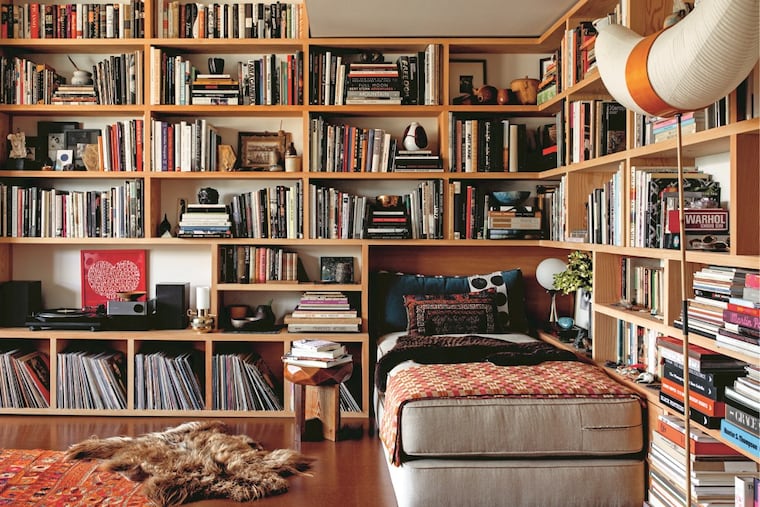Social isolation, and video chats, are renewing attention to the art of the bookshelf
Self-isolation has people rediscovering the value of having hardcovers at home. Pair books with objects, art, photographs and ephemera.

Bookshelves are having a moment.
Not long ago, their epitaph was being written. Ikea's redesign of its Billy unit to accommodate objects other than books was cited as evidence that we had turned the page on possessing print.
Now, that story has a sequel.
Self-isolation has people rediscovering the value of having hardcovers at home. In addition, television networks’ shift to interviews by Skype, rather than in a studio, is revealing the bookcase backdrops of pundits, news anchors and celebrities at home. That domestic exposure sparked a social media conversation about literary decor.
Room Rater on Twitter, for example, offers regular, and often snarky, critiques of shelves in the rooms visible behind various talking heads.
Room Rater dishes compliments, too. "Just enough clutter," one tweet reads. "Looks real."
Domestic libraries are first and foremost about books. But the displays also lend an inviting graphic element to decor. Just please, designers say, don't arrange books page-side out. That affectation makes no sense. However, please do pair books with objects, art, photographs and ephemera.
The book Bibliostyle: How We Live at Home with Books by Nina Freudenberger showcases enviable bookshelves around the world. Photos of collections and the rooms they inhabit are accompanied by interviews with their well-read and often-notable owners.
The hardcovers pictured here make you want to read — and display — more books.
» READ MORE: Indie bookstores in Philly, the burbs and N.J. where you get books during quarantine
Bibliostyle features more than 250 color photographs of 35 homes in 15 cities and eight countries. Residences include the homes of writers, illustrators, designers, editors and collectors — readers all.
Highlighted rooms range from clean contemporary to overstuffed classic. Shelves showcase rare editions, fairy tales, gardening volumes, coffee-table tomes and even vintage comic books. There are books in closets and bedside stacks, books on landings and books lining dining room walls. They’re arranged by color, by author, by language, by genre or not organized at all.
"People live in different ways," says Freudenberger, a Los Angeles-based interior designer. "I think to not have books, it's a red flag. It makes me a little nervous. Books have something incredible. The smell. They're an object. There's a legacy."
True to her Rhode Island School of Design education in architecture, however, Freudenberger does appreciate creative order.
"I don't think you have to jam every shelf full," she says. "Empty space is important."
She suggests using bookends for visual breaks and is fond of natural wood shelving, which, she says, is warm and accentuates the books.
» READ MORE: 10 big books for summer 2020
Bloomfield Hills, Mich., interior designer Dayna Flory Rasschaert, of Dayna Flory Interiors, says: “Books can be a tricky item to visually conquer. Trust me, there is no better feeling than the warmth of being surrounded by books. However, if not properly allocated, they can become visually overwhelming and very busy to the eye.”
She, like many designers, finds a crazy quilt of paperbacks and book jackets visually jarring. Some will remove paper jackets or cover books with paper or custom bindings for a more calming uniformity.
"I arrange the books by genre, and very importantly, by color," she says. "Grouping the books by color gives visual order and quiet."
New York interior designer Celerie Kemble, author of To Your Taste, says custom built-in bookcases are ideal and are especially appealing when they surround windows.
Whatever the display, she writes, "A well-used bookcase offers heft, stability, backbone, character and a sense of life lived."
The libraries featured in Bibliostyle are stunning examples of the substance that books lend — intellectually, aesthetically and emotionally.
Nashville-based poet and author Caroline Randall Williams, whose heirloom cookbook collection is featured, speaks to the emotional value.
“If the house were burning,” she says, “I’d probably rush to save The New World Encyclopedia of Cooking, purely because Nana pressed fresh flowers into its pages, and I would be heartbroken if I failed to preserve them.”
» READ MORE: Readers stuck at home need books — and community. Here’s how to get both.
Concern for an orderly display is often less important than the pleasure of the collection itself. Still, the collectors’ homes in Bibliostyle make up an inspiring portfolio of interior and architectural design. There are high-ceilinged European apartments, a poured-concrete modern in Mexico City, and a wonderfully layered 19th-century New York farmhouse with windows framing Hudson Valley views like color plates in a vintage book.
More minimalist homes also are depicted. Emmanuel de Bayser, a proprietor of concept stores in Paris and Berlin who says he doesn’t understand people who don’t have books, has a collection tailored to fit the mid-century modern decor of his Berlin apartment.
“To be honest, in Paris, I went to find several clothbound books in specific colors,” de Bayser is quoted as saying. "The priority was the looks. But one is a special edition of [the poet Rainer Maria] Rilke.
Many of the featured book lovers have arranged their furnishings to accommodate reading.
After visiting the homes of the featured aficionados, Freudenberger reached her own conclusion about the elements of a really good reading chair. Being near natural light is nice, she says, and she likes the idea of proximity to the kitchen.
The most inviting spot among those pictured may be in a vignette from the Brooklyn brownstone of writer Kathleen Hackett and artist Stephen Antonson. A chair, known as “the Chair,” with an appealingly broken-in sheepskin, is the most coveted reading spot in the house.
It is, of course, beside a bookshelf.